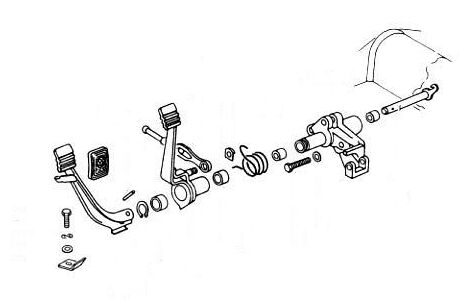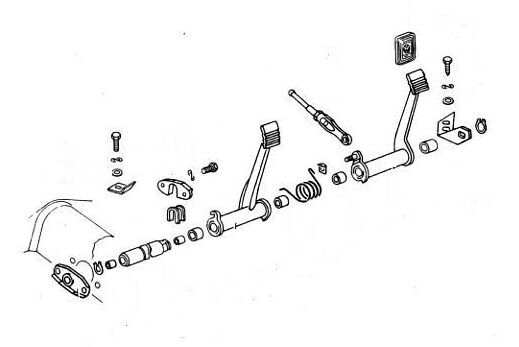Clutch
Cable Discussion
Please
see also our Clutch Cable Replacement
Procedure.
~~~
There
is a wide variety of clutch cable lengths available - it's
important that you get the right one. The following table
lists the various cables (by length) and gives their
applications -
Cable
Length
|
Application
|
|
2250mm
|
Beetle /Ghia 61
|
|
2260mm
|
Beetle/Ghia 62 - 71
|
|
2268mm
|
Beetle 5/74 - 79/Ghia 5/74
|
|
2281mm
|
Beetle 72 - 4/74/Ghia 4/74
|
|
3110mm
|
Bus 6/59 - 60
|
|
3116mm
|
Bus 50 - 5/59
|
|
3200mm
|
Bus 68 - 71
|
|
3215mm
|
Bus 72-79
|
The
cables all attach the same, by way of an "eye" on
the pedal end.
Rob
writes - On my right-hand drive (RHD) model I remove the
cover plate from the left side of the tunnel (where the
pedals on the left-hand drive (LHD) come out), and the hook
is visible at that edge of the tunnel. The clutch cable is
fed in from the front to the back on all models as far as I
know. It's difficult to start the cable into the tube, as the
threaded end doesn't allow much room to bend the cable -- but
not too difficult.
And
knowing VW it will be the same cover plate which is moved to
the left side -- they seem to be very good at designing parts
which will work with both models. On the Standard Bugs I
believe the tie rods etc. are simply reversed.
The
pedal cluster is different, of course, between the RHD and
the LHD models. On LHD cars the accelerator pedal axle is the
outer of the nested axles and the clutch is the inner one. On
RHD cars that's reversed -- the accelerator axle is the inner
one, since is comes from the far right on RHD models. If you
remove the pedal cluster on LHD models you'll find the front
end of the clutch cable just inside the tunnel -- it has a
rectangular "eye" on it which hooks over a hook on
the pedal cluster. The accelerator and clutch hooks end up in
the same position, so the cable runs are the same.

Pedal
Assembly - LHD
~~~

Pedal
Assembly - RHD
~~~
The
cable is withdrawn through the front and of course if it's
broken you'll have to pull the rear section out from the rear
end too.
Replacing
the clutch cable is not really hard. So long as the tube it
runs in is okay, it's a relatively straight-forward job. The
clutch tube runs the full length of the tunnel, so once you
have the cable started inside the tube it feeds in easily.
Getting the new cable started in the tunnel tube it a bit
awkward - there is only JUST enough room to get the solid
threaded end in first, then the flexible part feeds through
easily. It's a good idea to coat the whole cable with grease
as you feed it in (making it a very messy job). It doesn't
really matter what kind of grease you use, so long as it's
not too heavy - otherwise it will get very sticky in snowy
weather and might make the clutch operation heavier on your
foot. Wheel bearing grease works best.
At
the rear end the cable has to go through the clutch operating
arm on the side of the gear box and then you install the wing
nut (or double lock nut if you have the old style of cable).
Adjusting
the slack out of the cable is difficult as there is not much
working room over the gearbox, but persevere until you have
the clutch working in the first half of pedal travel - not
down near the floor. See our Clutch
Adjustment procedure.
Dave
wrote - I recall having trouble getting the clutch cable
through the Bowden tube -- fussed and fussed with it until it
dawned on me that the Bowden tube had to be removable (I'd
seen replacements in the catalog). Once I had the Bowden tube
removed (it took a strong arm) feeding the clutch cable
through it was easy.
The
cable CAN be replaced without removing the Bowden tube, but
if the bend in the tube needs adjusting, it has to be
moved/removed anyway.
*
* * * *
|